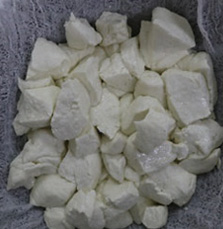ศึกษาคุณภาพและอายุการเก็บรักษาของมอสซาแรลล่าชีสที่ผลิตในธุรกิจขนาดเล็ก
คำสำคัญ:
มอสซาแรลล่าชีส, คุณภาพทางกายภาพ-เคมี, การทดสอบทางประสาทสัมผัส, อายุการเก็บรักษาบทคัดย่อ
การทดลองนี้มีวัตถุประสงค์เพื่อศึกษาคุณภาพทางกายภาพ-เคมี การทดสอบทางประสาทสัมผัส และอายุการเก็บรักษาของมอสซาแรลล่าชีสจากน้ำนมโคที่ผลิตแบบไม่ซับซ้อนในธุรกิจขนาดเล็กสำหรับผู้ประกอบการรายย่อย โดยใช้น้ำนมโคดิบไขมันเต็มในการผลิตและไม่เติมสารใด ๆ เพิ่มเติมในการปรับปรุงคุณภาพ เช่น ครีม แคลเซียมคลอไรด์ เป็นต้น วางแผนการทดลองแบบ completely randomized design (CRD) แบ่งกลุ่มทดลองเป็น 5 กลุ่ม ตามอายุการเก็บรักษาวันที่ 0, 7, 14, 21 และ 28 ตามลำดับ ที่อุณหภูมิ 4 องศาเซลเซียส ผลการทดลองพบว่า เปอร์เซ็นต์ความชื้นในวันที่ 28 มีค่าต่ำสุดที่ 38.12 เปอร์เซ็นต์ ซึ่งค่าลดลงอย่างมีนัยสำคัญทางสถิติตลอดอายุการเก็บรักษา (p<0.05) ค่าความเป็นกรด-ด่าง (pH) ในวันที่ 0 มีค่าสูงสุดเท่ากับ 6.61 (p<0.05) ค่าน้ำอิสระ (aw) ในวันที่ 28 มีค่าสูงสุดคือ 0.96 (p<0.05) และวันที่ 28 ของการเก็บรักษามีเปอร์เซ็นต์ไขมันสูงสุดที่ 22.75 เปอร์เซ็นต์ ซึ่งเปอร์เซ็นต์เพิ่มขึ้นอย่างมีนัยสำคัญทางสถิติ (p<0.05) ส่วนการทดสอบทางประสาทสัมผัส พบว่า คะแนนลักษณะปรากฏ เนื้อสัมผัส กลิ่นและรสชาติ และคะแนนความพึงพอใจโดยรวม แตกต่างกันอย่างไม่มีนัยสำคัญทางสถิติ (p>0.05) ตลอดเก็บรักษา 28 วัน
เอกสารอ้างอิง
ชูศักดิ์ จอมพุก. 2555. สถิติ: การวางแผนการทดลอง และการวิเคราะห์ข้อมูลในงานวิจัยด้านพืชด้วย “R” พิมพ์ครั้งที่ 2. สำนักพิมพ์มหาวิทยาลัยเกษตรศาสตร์, กรุงเทพมหานคร. 335 หน้า.
บุศรินทร์ ชนะคช. สุเจตน์ ชื่นชม และ ศศิธร นาคทอง. 2563. การศึกษาระดับเอนไซม์เรนเนทที่เหมาะสมต่อการผลิต มอสซาแรลล่าชีสจากน้ำนมโคและน้ำนมแพะ. วารสารวิทยาศาสตร์เกษตรและการจัดการ 3(2): 81-86.
สำนักเศรษฐกิจอุตสาหกรรม. 2560. ตลาดชีสในประเทศไทย. (ระบบออนไลน์). แหล่งข้อมูล: http://fic.nfi.or.th/MarketOverviewDomesticDetail.php?id=134 (2 มีนาคม 2564).
Ahmed, S., I. Gaucher, F. Rousseau, E. Beaucher, M. Piot, J.F. Grongnet and F. Gaucheron. 2008.
Effects of acidification on physic-chemical characteristics of buffalo milk, a comparison with cow’s milk. Food Chemistry 106: 11-17.
A.O.A.C. 2000. Official Methods of Analysis of AOAC International. 17th ed. The Association of Official Analytical Chemists, Gaithersburg, Maryland The United States of America.
Bhattarai, R.R and P.P. Acharya. 2010. Preparation and quality evaluation of mozzarella cheese from different milk sources. Journal of Food Science and Technology Nepal. 6: 94-101.
Brown, J. A., E. A. Foegeding, C. R. Daubert, M. A. Drake and M. Gumpertzt. 2003. Relationships among rheological and sensorial properties of young cheese. Journal of Dairy Science. 86: 3054-3067.
Bylund, G. 1995. Dairy Processing Handbook. Tetra Pak Processing Systems ABS, Lund. Sweden. 436 p.
Dai, S., F. Jiang, H. Corke and N.P. Shah. 2018. Physicochemical and textural properties of mozzarella cheese made with konjac glucomannan as a fat replacer. Food Research International 107: 691-699.
El-Tahra, M., A. Ammar, M. M. Ismail and R. I. El-Metwally. 2008. Effect of adding CaCl2 or whey protein to cow's milk on Mozzarella cheese properties. pp.1-17. In: Conference: The 4th Arab Mansoura Conference of Food and Dairy Science & Technology. Faculty of Agriculture, Mansoura University, Egypt.
Fangmeier, M., G.T. Kemerich, B.L. Machado, M. J. Maciel and C.F. Volken de Souza. 2019. Effects of cow, goat, and buffalo milk on the characteristics of cream cheese with whey retention. Food Science and Technology 39: 122-128.
CODEX Alimetarius International Food Standards. 2006. Standard for mozzarella cheese 262-2006. SEARCA professorial chair paper. Food and Agriculture organization of the United Nation. The United States of America. 9 p.
Guven, M., C. Cadun, O.B. Karaca and A. A. Hayaloglu. 2008. Influence of rennet concentration on ripening characteristics of halloumi cheese. Journal of Food Biochemistry 32(5): 615–627.
Kingchaiyaphum, W. and C. Rachtanapun. 2012. Antimicrobial and antioxidative active of essential oils in Chinese sausage (Kun-Chiang). Asian Journal of Food and Agro-Industry 5(2): 156-162.
Ma, X., B. James, M.O. Balaban, L. Zhang and E. A.C. Emanuelsson-Patterson. 2013. Quantifying blistering and browning properties of mozzarella cheese. Part II: Cheese with different salt and moisture contents. Food Research International 54(1): 917-921.
McMahon, D.J., M.M., Motawee and W.R, McManus. 2009. Influence of brine concentration and temperature on composition, microstructure, and yield of feta cheese. Journal of Dairy Science 92: 4169–4179.
Pagliarini, E., E. Monteleone and I. Wakeling. 1997. Sensory profile description of mozzarella cheese and its relationship with consumer preference. Journal of Sensory Studies 12(4): 285-301.
Papetti, P. and A.Carelli. 2013. Composition and sensory analysis for quality evaluation of a typical Italian cheese: Influence of ripening period. Czech Journal of Food Sciences 31(5): 438-444.
Sameen, A., F.M. Anjum, N. Huma and H. Nawaz. 2008. Quality evaluation of mozzarella cheese from different milk sources. Pakistan Journal of Nutrition 7(6): 753-756.
Sanchez-Macıas, D., I. Moreno-Indias, S. Alvarez, M. Clevelan, N. Castro, A. Arguello and M. del Rosario Fresno. 2012. Sensory analysis of full -, reduced- and low-fat cheese elaborated with raw goat milk. Journal of Applied Animal Research 40(2): 124-132.
Singh, M.P., S.K. Kanawjia, A. Giri and Y. Khetra. 2014. Effect of temperature and microcrystalline cellulose on moisture sorption characteristics of shredded mozzarella cheese. Journal of Food Processing and Preservation 39(5): 521-529.
Smit, G., B. A. Smit, J. M. Wim and J. M. Engels. 2005. Flavour formation by lactic acid bacteria and biochemical flavor profiling of cheese products. FEMS Microbiology Reviews 29(3): 591-610.
Sulieman, E., A. Rasha, Mohamed Ali, A. Kamal and A. Abdel Razig. 2012. Production and effect of storage in the chemical composition of mozzarella cheese. International Journal of Food Science and Nutrition Engineering 2(3): 21-26.
USDA. 2016. Commodity Requirements Document Mozzarella Cheese for Use in Domestic Programs. The United States Department of Agriculture, The United States of America.






